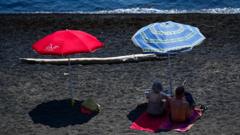In 2025, Venice will enforce a fee for tourists on 54 days, aiming to alleviate congestion and protect the city's heritage.
Venice Expands Tourist Entrance Fee Strategy Amid Overtourism Concerns

Venice Expands Tourist Entrance Fee Strategy Amid Overtourism Concerns
Venice's mayor announces an increase in the number of days tourists are required to pay an entrance fee to address overtourism.
Venice is set to implement significant changes to its tourist entrance fee system, with plans to double the number of days visitors must pay. As reported by the city's mayor, Luigi Brugnaro, the decision follows a successful trial run from last year. The aim is to manage tourist influx and provide the city with the respect it merits. Those visiting as day-trippers will now need to pay €5 (£4.17; $5.41) for access if they book in advance, and €10 for last-minute bookings made less than four days prior, between April and July of 2025.
Initially introduced in April 2024, the entrance fee covered 29 selected days, primarily weekends and public holidays, over a span of four months. The expanded charge will apply on weekends and public holidays from April 18 to July 27, 2025, representative of a more structured and possibly more impactful attempt to manage tourist activity during peak times. According to plans, visitors over 14 will be required to pre-purchase tickets via a mobile app and present a QR code to inspectors at common points of entry, such as train stations. Failure to comply could result in fines.
Certain groups will remain exempt from the fee, including residents of the Veneto region, students enrolled at Venetian universities, and those visiting friends or family in the city. City councillor Simone Venturini noted that Venice's proactive measures against overtourism have positioned it as a leader in global responses to tourism challenges.
The initial implementation in April yielded promising results, with Venice authorities reportedly raising expected revenue within just eight days. With total collections reaching approximately €2.4 million (£2 million; $2.5 million) by the trial’s conclusion in July, discussions remain on whether these revenues will balance against the scheme's operational costs, which stood at around €3 million, according to Italian sources.
However, opposition councillor Giovanni Andrea Martini critiqued the system as ineffective, asserting that it failed to distribute tourists more evenly across the city and warned that increasing fees could ultimately render Venice akin to a mere museum experience. The cultural site has already faced scrutiny from UNESCO, suggesting inclusion on a list of world heritage sites under threat due to climate change and mass tourism impacts.
Venice also took decisive action against large cruise ships in 2021, banning them from entering its historic center after incidents of damage and pollution, a measure reflecting growing concerns over the sustainability of the city's tourism model. The debate continues: how can Venice, a UNESCO World Heritage site, balance the economic benefits of tourism with the need for preservation amidst the challenges posed by an ever-increasing number of visitors?





















